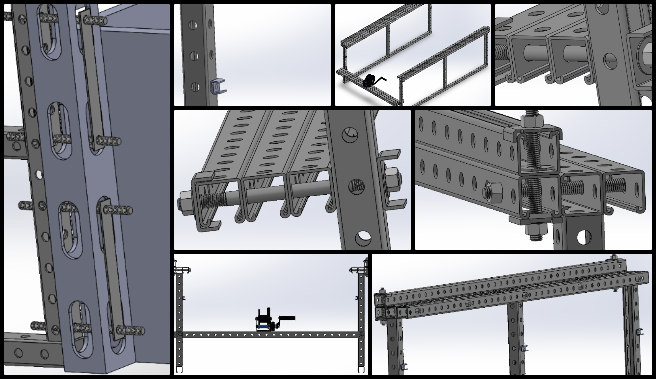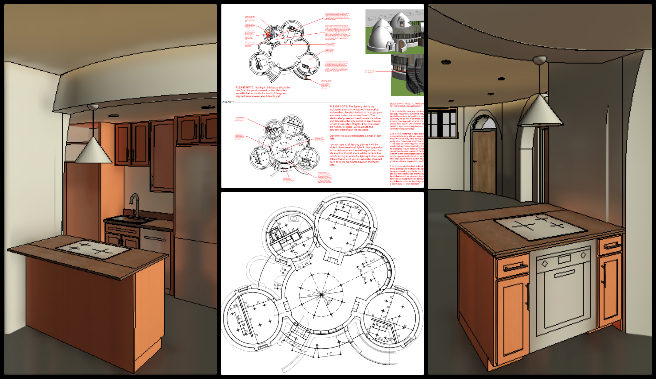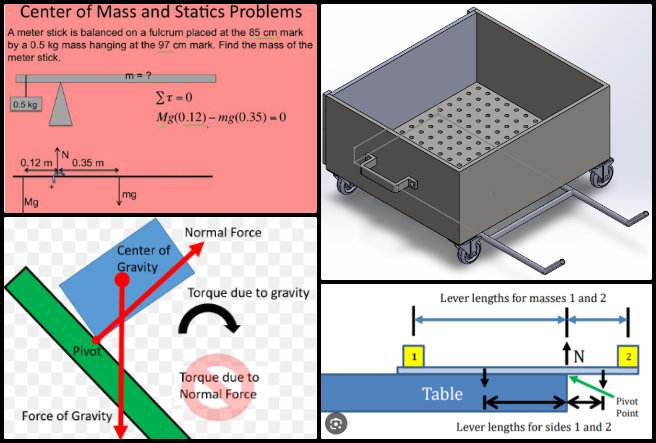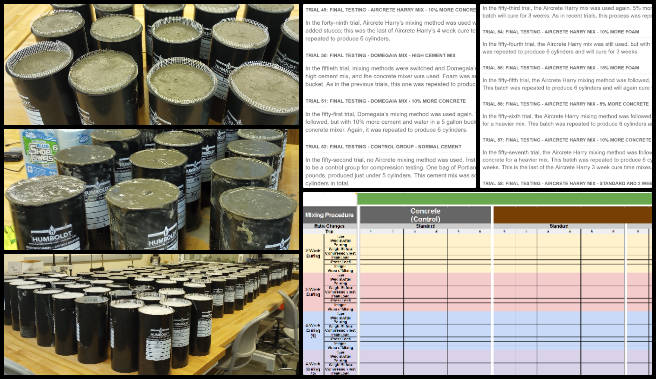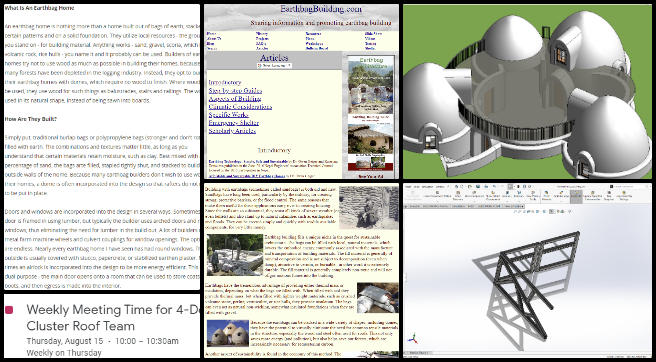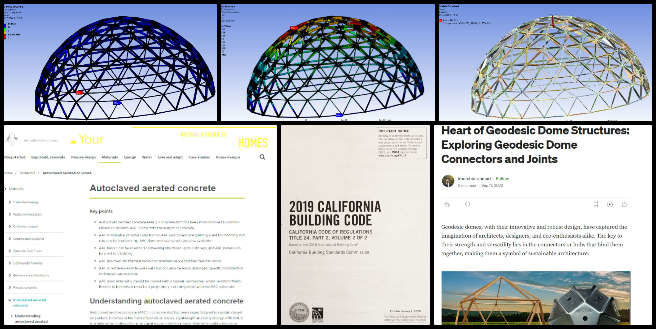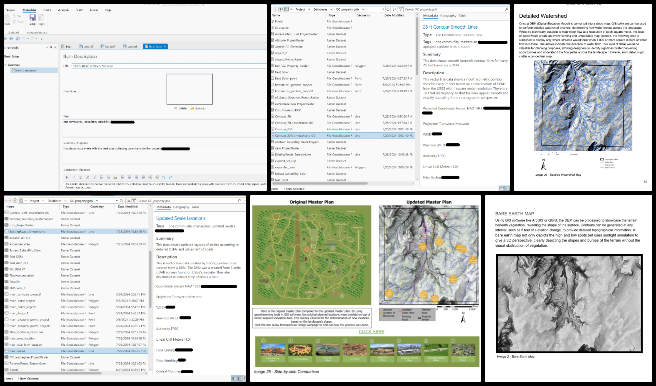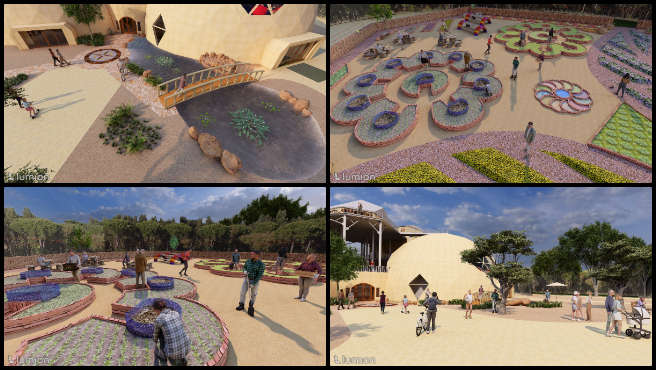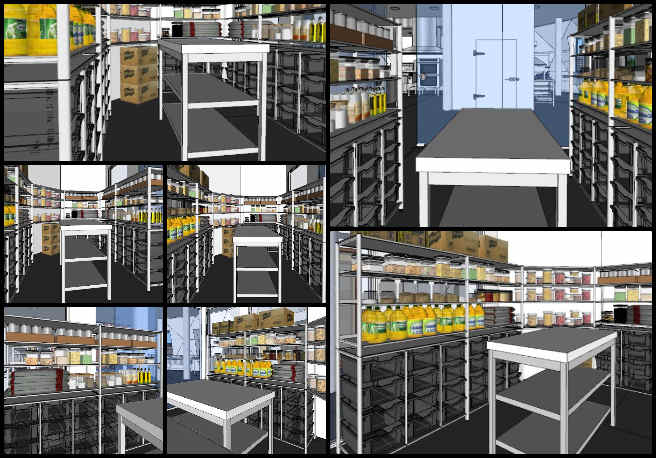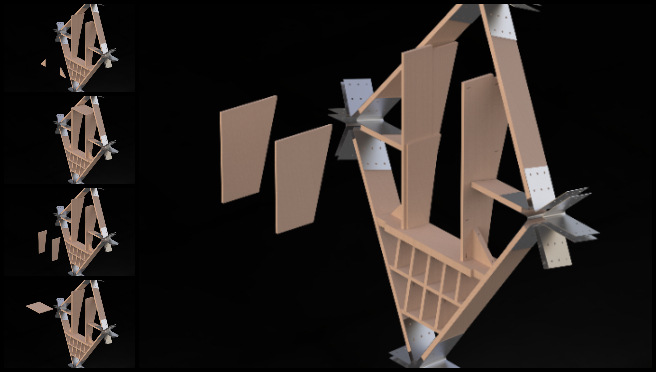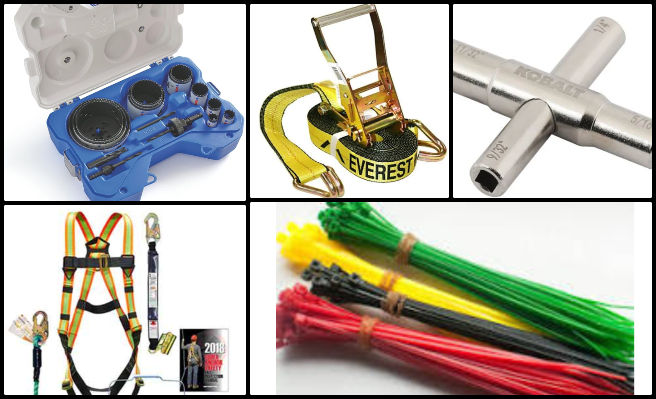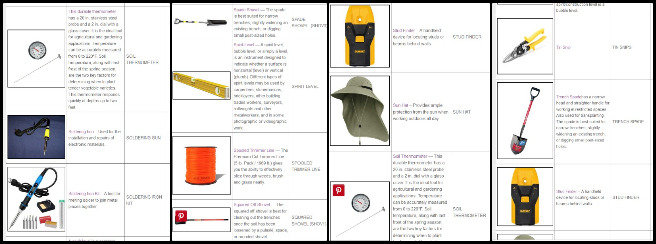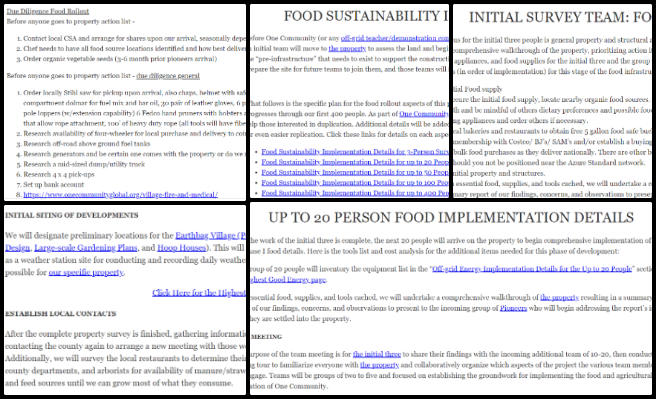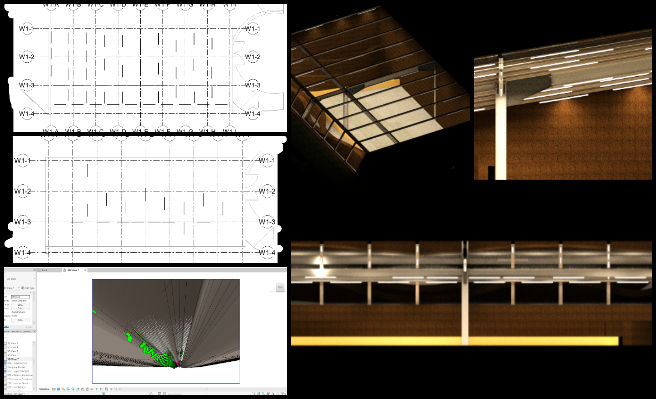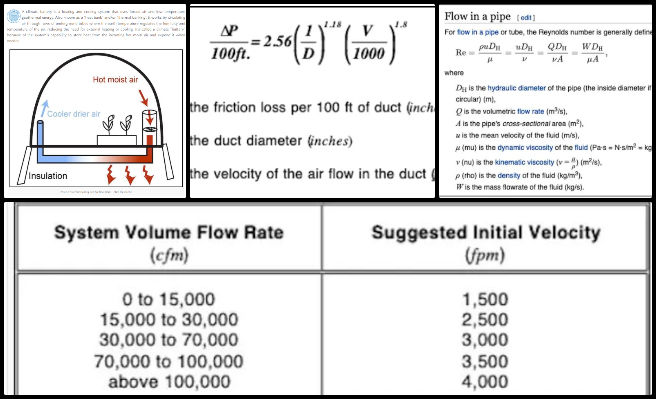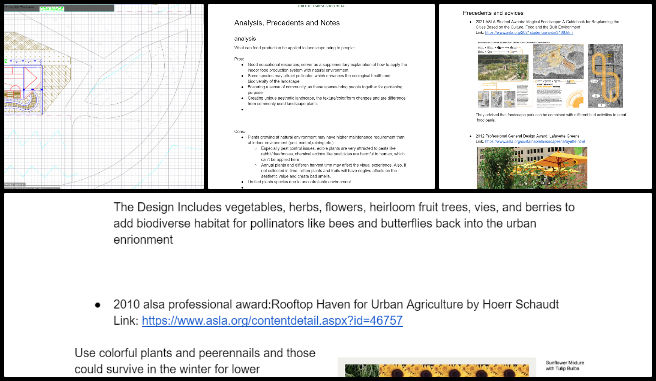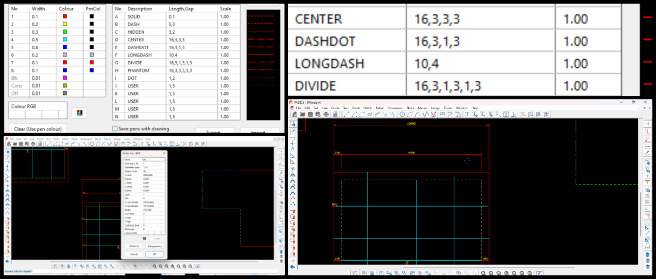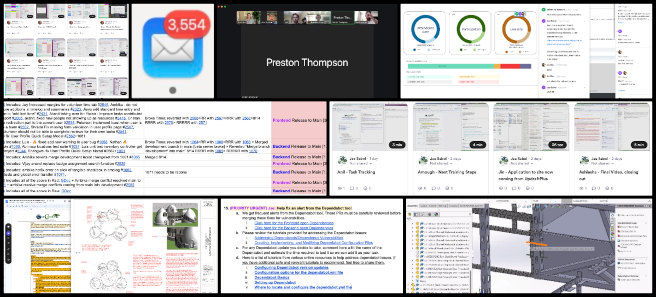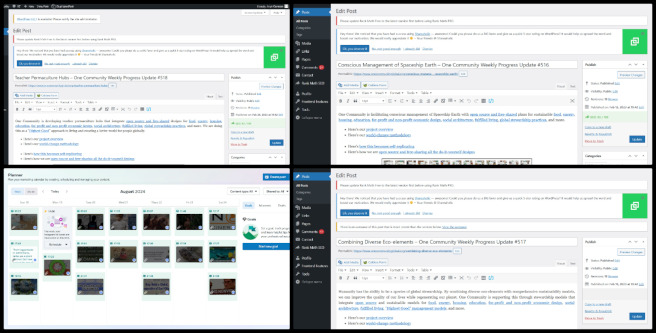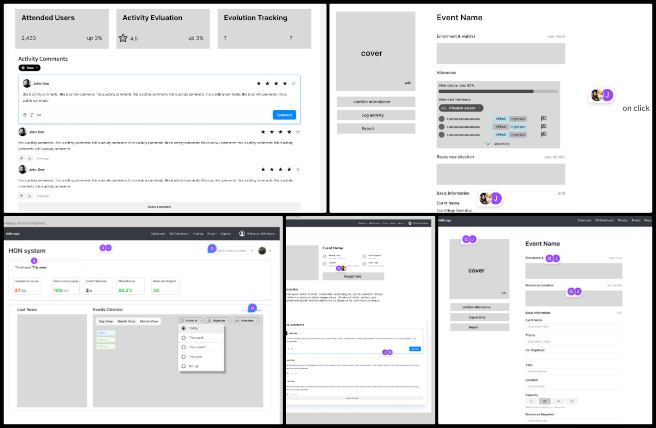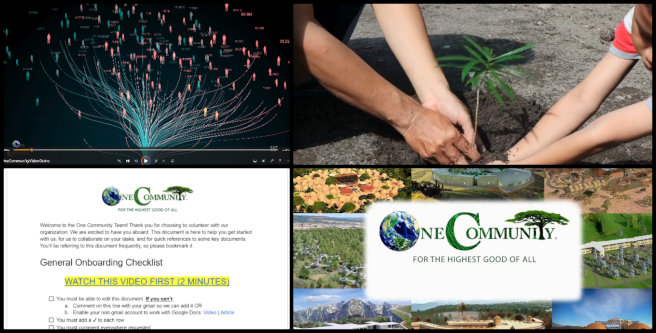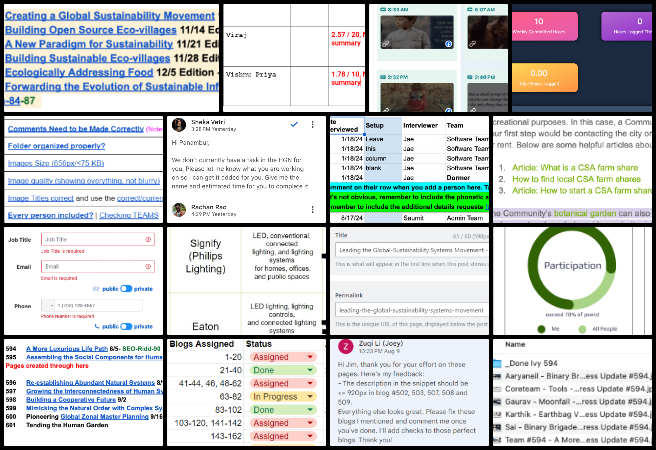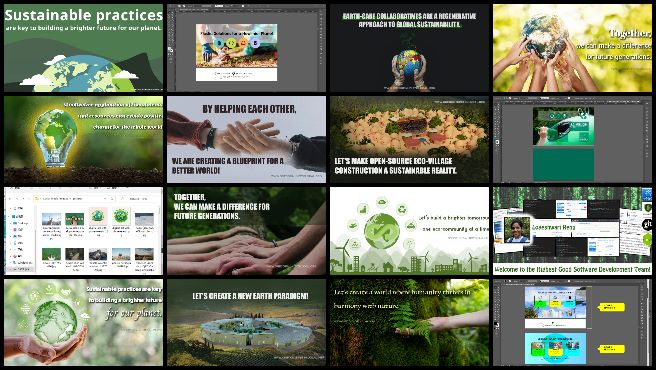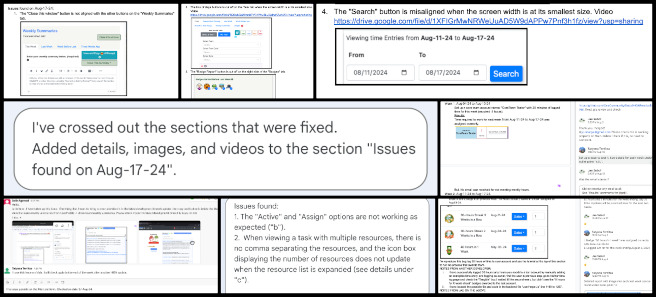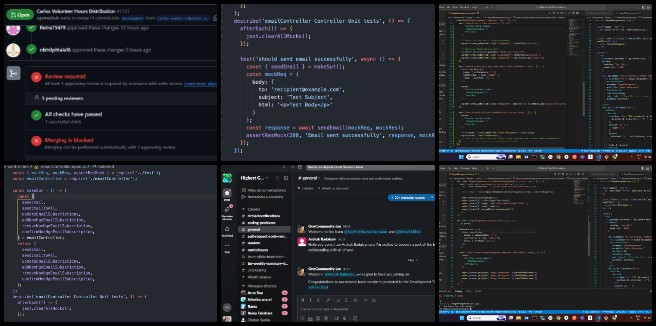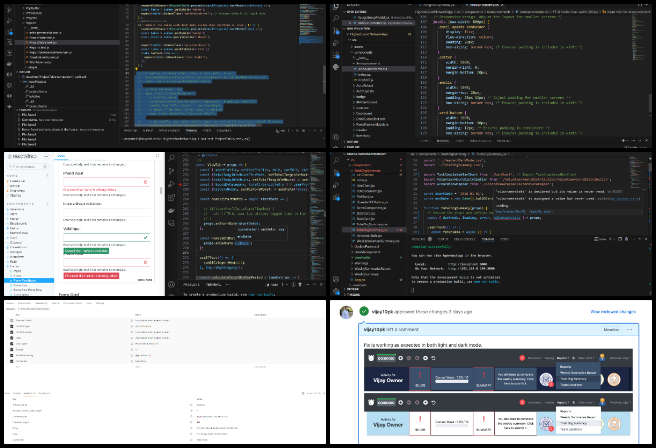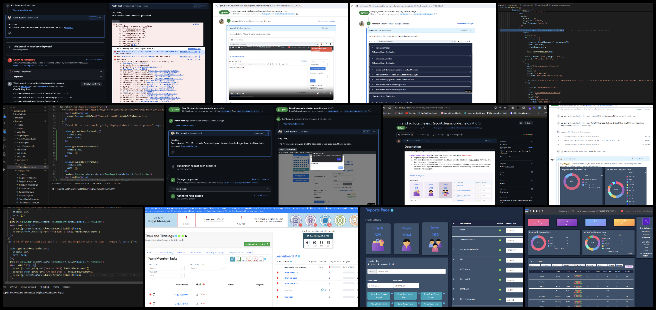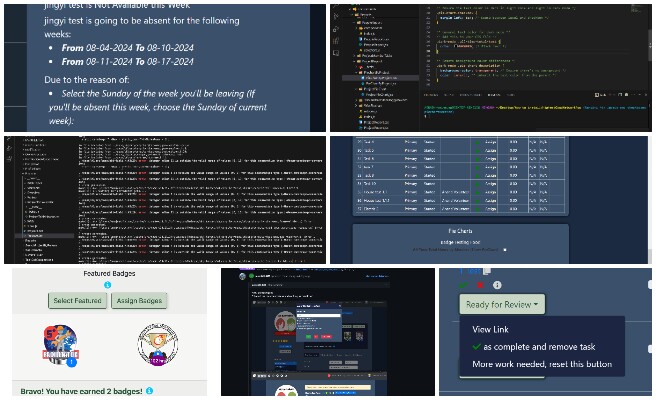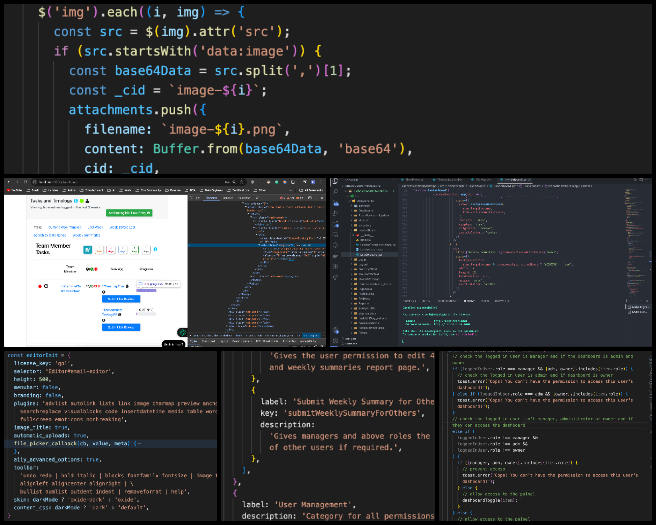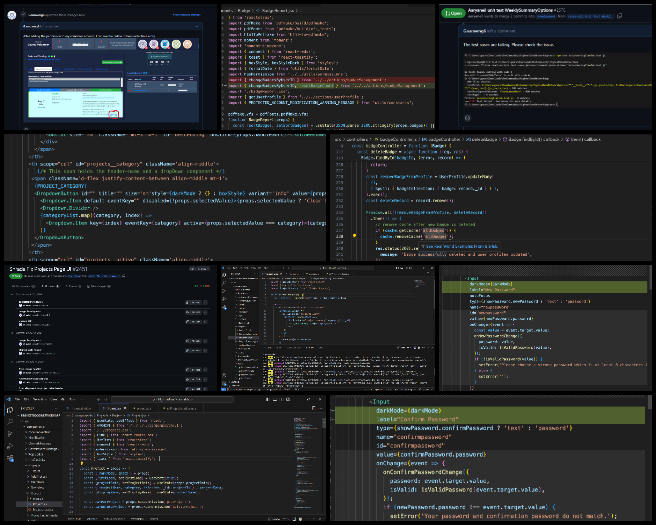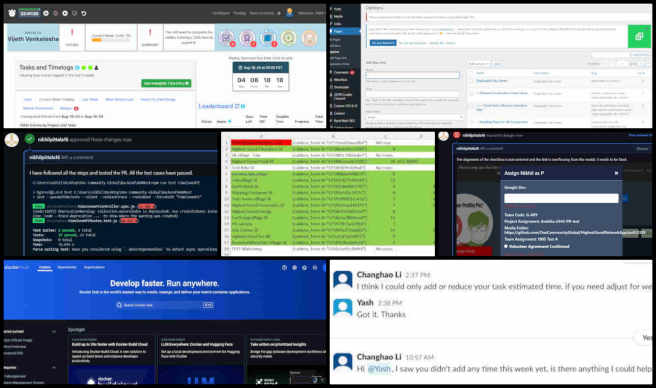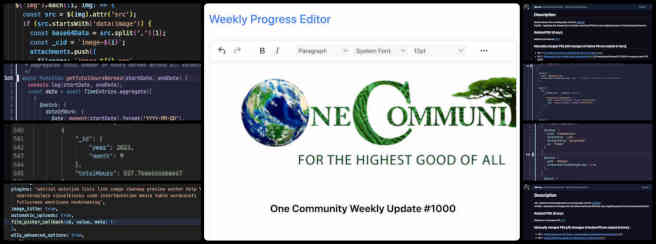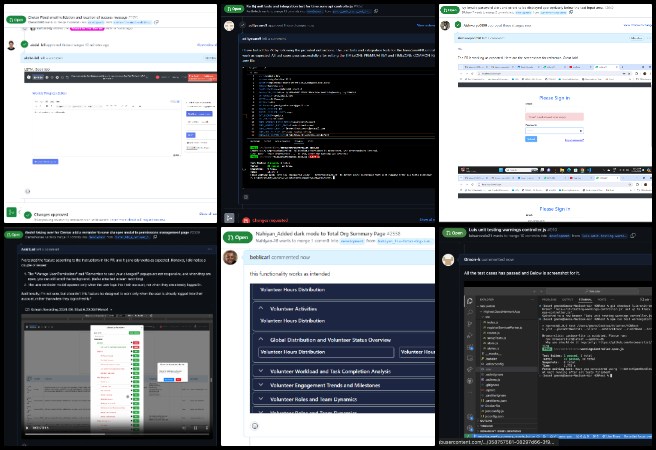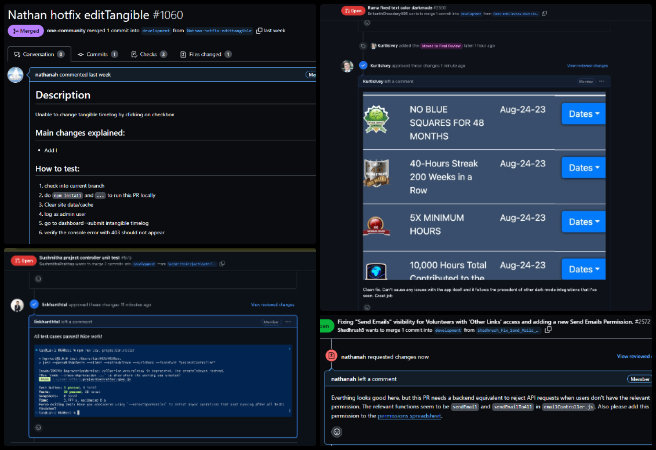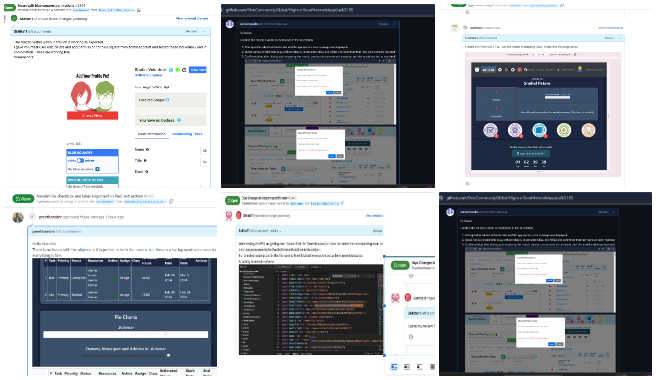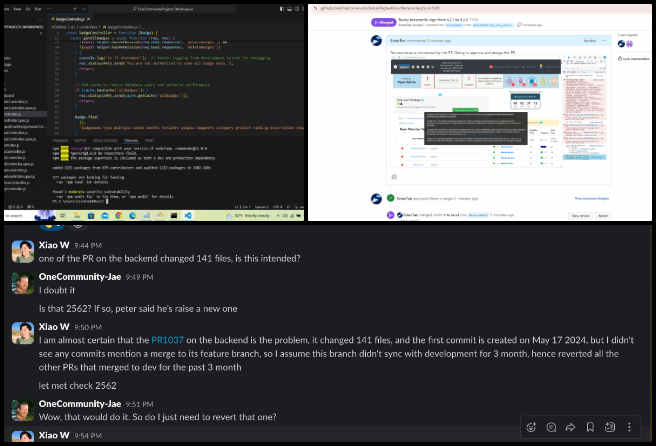Re-establishing Abundant Natural Systems – One Community Weekly Progress Update #596
At One Community, we are re-establishing abundant natural systems through sustainable approaches to food, energy, housing, education, economics, and social architecture. Created by an all-volunteer team, we are evolving sustainability into a self-replicating model that supports fulfilled living and global stewardship practices. By open sourcing and free sharing the complete process, we aim to create a global collaboration of teacher/demonstration hubs dedicated to regenerating our planet and doing everything for “The Highest Good of All“.
- Here’s our project overview
- Here’s our world-change methodology
- Here’s how this becomes self-replicating
- Here’s how we are open source and free-sharing all the do-it-yourself designs
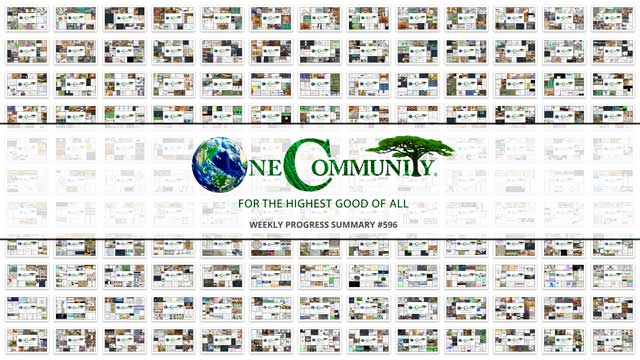
OUR MAIN OPEN SOURCE HUBS
Click on each icon to be taken to the corresponding Highest Good hub page.
One Community’s physical location will forward this movement as the first of many self-replicating teacher/demonstration communities, villages, and cities to be built around the world. This is the August 19th, 2024 edition (#596) of our weekly progress update detailing our team’s development and accomplishments:
Re-establishing Abundant Natural Systems
One Community Progress Update #596
DONATE | COLLABORATE | HELP WITH LARGE-SCALE FUNDING
CLICK HERE IF YOU’D LIKE TO RECEIVE AN EMAIL EACH WEEK WHEN WE RELEASE A NEW UPDATE
YOU CAN ALSO JOIN US THROUGH SOCIAL MEDIA
ONE COMMUNITY WEEKLY UPDATE DETAILS
HIGHEST GOOD HOUSING PROGRESS
 One Community is re-establishing abundant natural systems through Highest Good housing that is artistic and beautiful, more affordable, more space efficient, lasts longer, DIY buildable, and constructed with healthy and sustainable materials:
One Community is re-establishing abundant natural systems through Highest Good housing that is artistic and beautiful, more affordable, more space efficient, lasts longer, DIY buildable, and constructed with healthy and sustainable materials:
- Learn about how we are re-establishing abundant natural systems: Our Upcoming Crowdfunding Campaign
- Learn about the different village models: 7 Sustainable Village Models
- Visit the open source portals for the first two: Earthbag Village OS Hub | Straw Bale Village OS Hub
This week, Joseph Osayande (Mechanical Engineer) continued helping finish the Vermiculture Toilet engineering and design details. The reference list in the document for the vermiculture bin maintenance report was cleaned up, and numbered references were added throughout the document. The finishing touches on the Unistrut stand were completed, including securing all bolts and screws to ensure the parts are fully secured and function as intended. Corner brackets were added to connect the struts, and the main brackets were added to connect the support structure to the chamber. Additionally, holders for the steel plate on the strut were installed, though the weight capacity is yet to be determined. This model aims to offer sustainable solutions that not only address waste processing but also enhance living standards, contributing to the model of re-establishing abundant natural systems. See below for some of the pictures related to this work.
Michaela Silva (Architect) continued working on finalizing the interior of the Earthbag Village 4-dome home design. Michaela created the lighting plan for the 4 Dome House and created the necessary sheets and views in the Revit model. She also developed a Revit titleblock family for use by all members of One Community working on Revit-based projects. Additionally, Michaela completed her bio paragraph and provided a picture for inclusion on the website. The Earthbag village is the first of 7 villages to be built as part of One Community’s open source model for re-establishing abundant natural systems. See her work in the collage below.
Yagyansh Maheshwari (Mechanical Engineer) also continued helping finish the Vermiculture Toilet engineering and design details. This week, Yagyansh worked on designing methods for efficiently dumping compost on the ground. He made modifications to the drawer and its materials in SolidWorks, incorporating L clamps and a mechanism to assist with emptying the drawer. He also explored various options for transferring the drawer to the dumping site, finalized wheels that met the required weight capacity, and performed torque calculations for tipping the drawer. The Earthbag Village is the first of 7 to be built as the housing component of One Community’s open source model for re-establishing abundant natural systems. See some of his work in the collage below.
AIRCRETE TEAM
The Aircrete Testing Team’s summary, covering their work on Aircrete Compression Testing was managed by John Sullivan (CBU Chemical Engineering Student) and includes Jonathan Crago (Civil Engineering Student), Preston Thompson (Civil Engineering Student), and Tad Matlock (Environmental Science Student). This week, Jonathan collaborated with his team to create additional aircrete cylinders and cement slurry cylinders, both with and without stucco fiberglass mesh. He also assisted in cleaning the lab and courtyard and recorded the data. The team secured more cement bags for upcoming tests. Preston and his team completed the production of all the aircrete samples needed for the summer, using a gas mixer to prepare approximately 18 samples of cement for the control group, now awaiting curing before testing. Tad reviewed and revised his previous work, reformatting and expanding the main spreadsheet for final compression testing data. He also wrote trial summaries and revised two introductory paragraphs to incorporate new information. Their work contributes to re-establishing abundant natural systems by improving building materials and sustainability practices.By improving the aircrete testing and production procedures, the team is re-establishing abundant natural systems for future developments. See below for some of the pictures related to this work.
EARTHBAG VILLAGE 4-DOME ROOF TEAM
The Earthbag Village 4-dome Roof Team was managed by Khushboo Parmar (Project Manager) and includes Karthik Pillai (Volunteer Mechanical Engineer) and Yusuf Thanawala (Structural Engineer). The Earthbag Village is the first of 7 villages creating One Community’s open source model for re-establishing abundant natural systems through sustainable housing. This week, Khushboo focused on researching Earthbag structures and Earthbag structures with roof decks to support the 4-Dome Roof Cluster Team. She also managed Michaela Silva and Adefola Madehin, and led the weekly team meeting for the 4-Dome Roof Cluster, where an issue with the support columns was identified. Karthik concentrated on understanding and evaluating the progress of the vermiculture toilet design project, gaining a clearer view of the design process and his future role. He also worked on the wooden paneling for the roof deck of the four-dome cluster roof project, which is nearing completion under Michaela’s leadership; the team will proceed with Finite Element Analysis (FEA) once the design is finished. Yusuf revisited the deck design to accommodate an irregular-shaped structure, studying additional requirements for the posts and joists. Insights from the team meeting were valuable, particularly from an architectural perspective, and he noted the need for design inputs from the owner, such as the selection of deck flooring material. The Earthbag village is an integral part of One Community’s open source model for re-establishing abundant natural systems. See their work in the collage below.
DUPLICABLE CITY CENTER PROGRESS
 One Community is re-establishing abundant natural systems through a Duplicable and Sustainable City Center that is LEED Platinum certified/Sustainable, can feed 200 people at a time, provide laundry for over 300 people, is beautiful, spacious, and saves resources, money, and space:
One Community is re-establishing abundant natural systems through a Duplicable and Sustainable City Center that is LEED Platinum certified/Sustainable, can feed 200 people at a time, provide laundry for over 300 people, is beautiful, spacious, and saves resources, money, and space:
- Learn about this building and it’s function for re-establishing abundant natural systems: Duplicable City Center Open Source Hub
This week, Arnob Mutsuddi (Mechanical Engineer) continued working on Duplicable City Center structural engineering model and details. His work involved reviewing the BIM architectural code for California (Vol-2) and studying its content. The research was focused on material selection for the U-shaped/Ring Hub Connector, with additional focus on autoclaved aerated concrete to assess its potential dead load. The Duplicable City Center is a foundational part of One Community’s open source model for re-establishing abundant natural systems. See some of this work in the pictures below.
Chris Blair (GIS Technician/Horticulturist) continued working with GIS data as part of One Community’s Permaculture Design that includes the location of the Duplicable City Center. He completed a second draft of the GIS content for the webpage, adding more content for clarity, revising graphics, and incorporating detailed watershed maps. Additionally, he continued creating metadata for the feature layers in ArcGIS to facilitate easier collaboration, improve reference, and streamline the import process to QGIS, an open-source GIS software. The Duplicable City Center is a foundational part of One Community’s open source model for re-establishing abundant natural systems. See some of this work in the pictures below.
Clarice Gaw Gonzalo (Architect) continued her work on the Duplicable City Center renders and visualizations, focusing on the outdoor vegetation and gardening space. She also worked on the natural filtration pond, determining the appropriate water density and reflection settings, and decorated the pond with water lilies and other plants. Additionally, Clarice created a trial video of the interior space. The Duplicable City Center is a foundational part of One Community’s open source model for re-establishing abundant natural systems. See some of this work in the pictures below.
Faeq Abu Alia (Architectural Engineer) began his work on the Duplicable City Center kitchen shelving and adding dry-storage food items. He researched and made adjustments to a shelf design in SketchUp, modifying its dimensions and layout to match the specifications from a video. After making the design changes, he organized and stocked the shelves to replicate the arrangement shown in the video. The Duplicable City Center is a foundational part of One Community’s open source model for re-establishing abundant natural systems. See below for some of the pictures related to this work.
Nika Gavran (Industrial Designer) continued her work on the Duplicable City Center dormer window installation plans. She focused on expanding the final document for the dormer window instructions, inputting text and images into Google Slides and organizing them by their respective sections. The Duplicable City Center is a foundational part of One Community’s open source model for re-establishing abundant natural systems. See below for some of the pictures related to this work.
HIGHEST GOOD FOOD PROGRESS
 One Community is re-establishing abundant natural systems through Highest Good food that is more diverse, more nutritious, locally grown and sustainable, and part of our open source botanical garden model to support and share bio-diversity:
One Community is re-establishing abundant natural systems through Highest Good food that is more diverse, more nutritious, locally grown and sustainable, and part of our open source botanical garden model to support and share bio-diversity:
- Learn about the structures: Hoop House Hub | Aquapini & Walipini Open Source Hub
- See what we’ll be growing: Gardens & Hoop Houses | Large-scale Structures | Food Forest | TA
Charles Gooley (Web Designer) continued working on the Transition Food Self-sufficiency Plan. He updated the Tools and Equipment for Open Source Construction master page by adding tools from the non-powered tools section of the Highest Good Food Tools, Equipment, Materials/Supplies design document. This included incorporating the soil thermometer and ensuring that all links displayed correctly in the address bar when accessed. The task required resizing images and copying text from the design document. Some duplicate entries were omitted from the update. Highest Good Food is key to re-establishing abundant natural systems within One Community’s open source plans. See some of this work in the pictures below.
Hayley Rosario (Sustainability Research Assistant) continued updating the Highest Good Food page after discovering that her previous progress had been erased, recreating the survey team, the 3-person team, and the 20-person team. She also worked through the implementation list and details, except for adding links. Highest Good Food is a key component for assembling and re-establishing abundant natural systems within One Community’s open source plans. See her work in the collage below.
Jay Nair (BIM Designer) continued working on Aquapini and Walipini Planting and Harvesting. This week involved progressing through Zones 2 to 26 of Walipini 1, focusing on selecting and placing linear LED fixtures on structural beams to ensure adequate coverage for each plant species. The work included addressing specific lighting needs for various plants and ensuring compliance with sustainability criteria. Additionally, challenges with graphical issues in Revit were encountered, particularly with interior views using the camera, which were slightly resolved by using exterior section views and generating night renders to demonstrate the lighting design effectively. Highest Good Food is a key component for assembling and re-establishing abundant natural systems within One Community’s open source plans. See his work in the collage below.
Prathamesh Jadhav (HVAC Design Engineer) continued working on Aquapini and Walipini Planting and Harvesting while reviewing a research paper on Climate Battery design that includes an overview of battery designs, formulas, references to YouTube links, details on designing an HVAC backup system, and how AutoCAD software is used. Highest Good Food is a key component for assembling and re-establishing abundant natural systems within One Community’s open source plans. See his work in the collage below.
Ziyi Chen (Landscape Designer) began working on the design of the outdoor spaces for the Aquapini/Walipinis structures. The onboarding process was completed, and Ziyi reviewed the provided documentation and familiarized herself with the work of previous teams on this food system. The focus was on analyzing the differences between the natural environment, climate, and both indoor and outdoor environments, identifying the advantages and challenges of sustainable food landscape design, and re-establishing abundant natural systems to understand its potential impacts on community residents. Ziyi also explored precedents related to food landscapes, urban agriculture, permaculture, and food gardens to inform the detailed functional design. Additionally, existing CAD files were used to start preparing base drawings of the outdoor space. Highest Good Food is a key component for assembling and re-establishing abundant natural systems within One Community’s open source plans. See her work in the collage below.
HIGHEST GOOD EDUCATION PROGRESS
 One Community is re-establishing abundant natural systems through Highest Good education that is for all ages, applicable in any environment, adaptable to individual needs, far exceeds traditional education standards, and more fun for both the teachers and the students. This component of One Community is about 95% complete with only the Open Source School Licensing and Ultimate Classroom construction and assembly details remaining to be finished. With over 8 years of work invested in the process, the sections below are all complete until we move onto the property and continue the development and open sourcing process with teachers and students – a development process that is built directly into the structure of the education program and everything else we’re creating too:
One Community is re-establishing abundant natural systems through Highest Good education that is for all ages, applicable in any environment, adaptable to individual needs, far exceeds traditional education standards, and more fun for both the teachers and the students. This component of One Community is about 95% complete with only the Open Source School Licensing and Ultimate Classroom construction and assembly details remaining to be finished. With over 8 years of work invested in the process, the sections below are all complete until we move onto the property and continue the development and open sourcing process with teachers and students – a development process that is built directly into the structure of the education program and everything else we’re creating too:
- Program Overview: Education Open Source Hub
- How the components work together: How to use the Education for Life Program
- Lesson Plans for Life – Lesson Plans How-to
- Foundations of Outstanding Leaders, Teachers, and Communicators
- Curriculum for Life
- Teaching Strategies for Life
- Learning Tools and Toys for Life
- Evaluation and Evolution
This week, Apoorv Pandey (Mechanical Engineer) continued helping with the engineering details for the Ultimate Classroom part of the Highest Good Education component. He continued working on the write-up for the report, updating the initial software and detailing each section to address any questions or changes requested, that are understood by engineers and the general public. He primarily focused on optimizing the tables for better presentation which was a challenging task due to difficulties in adjusting the column widths for each section, while re-establishing abundant natural systems to enhance the overall clarity and impact of the report. Apoorv also concentrated on formatting the calculation section following the guidelines provided by the senior engineer, Brian Muigai Mwaniki (Structural Engineer). The One Community model of combining forward-thinking education with sustainably built classrooms like this is an excellent example of re-establishing abundant natural systems. See the collage below for his work.
Brian Mwoyowatidi (Graduate Structural Engineer) continued helping with the engineering details for The Ultimate Classroom part of the Highest Good Education component. He focused on learning and improving his detailing skills in Prokon Padds software in preparation for detailing the Foundation section of a proposed calculation report by the team. He also began finalizing the Ultimate Classroom Footer, Foundation, and Flooring Design Tutorial and Report, addressing all questions and suggestions to make this tutorial more relatable to engineers and the general public. The One Community model of combining forward-thinking education with sustainably built classrooms like this is an excellent example of re-establishing abundant natural systems. See the collage below for his work.
HIGHEST GOOD SOCIETY PROGRESS
 One Community is re-establishing abundant natural systems through a Highest Good society approach to living that is founded on fulfilled living, the study of meeting human needs, Community, and making a difference in the world:
One Community is re-establishing abundant natural systems through a Highest Good society approach to living that is founded on fulfilled living, the study of meeting human needs, Community, and making a difference in the world:
- Read the Highest Good society overview: Highest Good Society
- Learn about the model for fulfilled living and sharing: A Day in the Life
- Learn about the 4 economic models: RBE | For-profit | Non-profit | Entrepreneurship
- Learn about our open source community collaboration and management software: The Highest Good Network
This week, the core team completed over 69 hours managing One Community’s volunteer-work review not included above, emails, social media accounts, web development, new bug identification and bug-fix integration for the Highest Good Network software, and interviewing and getting set up new volunteer team members. They also shot and incorporated the video above that talks about re-establishing abundant natural systems and how re-establishing abundant natural systems is a foundation of the bigger picture of everything One Community is doing. The image below shows some of this work.
Arun Chandar Ganesan (Volunteer Data Analyst and SEO and Social Media Assistant) focused on improving webpage SEO, reviewing numerous pages, including some previously abandoned ones. He also improved the scores of his previous web pages. Additionally, Arun managed and coordinated the scheduling of posts on One Community’s social media platforms such as Facebook, Instagram, Pinterest, and LinkedIn, and regularly updated the tutorials. This work helps One Community’s mission of re-establishing abundant natural systems. The following images show his work for the week.
Jia Shu (UX Designer) continued her work on the Highest Good Network phase 3 development that focuses on organizing and tracking the Fulfilled Living aspect of the Highest Good Society component. This week, she worked on refining existing elements and defining separate workflows for organizers and members, each with distinct functions such as recording attendee information and scanning QR codes for registration. Based on feedback from Joe’s video, she made several adjustments, including incorporating a QR code scan feature into the check-in process, updating the notification system to a pop-up style with options to decline, accept, or ignore, enhancing the visual UI for activity attendance rates, and adding filter and rating options to the comments section, along with other minor UI refinements. Jia also collaborated with John on refining the design of Phase 3, focusing on epics, user stories, tasks, and priorities. Feedback on low-fidelity prototypes led to the creation of mid-fidelity versions, and she studied web design and iOS/Android design systems to optimize the user experience. Additionally, she emphasized re-establishing abundant natural systems in the design, ensuring that the user interface promotes environmental sustainability and harmony with nature. The design system was structured around six epics and their respective user stories, with tasks for each epic. The design work was initiated in Figma, where a basic layout for each function is currently in place. The UI system which includes colors and icons, was also halfway defined and is awaiting John’s confirmation. This work helps One Community’s mission of re-establishing abundant natural systems. The picture below shows some of this work.
Shireen Kayal (Humanitarian Program Developer & Data Manager) completed the onboarding checklist, checked the boxes, and added comments where required. She reviewed the action items, put together a sample video to assess the quality of work, created an intro and outro for the weekly progress video, and captured footage of the weekly progress. This work helps One Community’s mission of re-establishing abundant natural systems. The following images show her work for the week.
ADMINISTRATION TEAM
The Administration Team’s summary, covering their work administrating and managing most of One Community’s ongoing process for re-establishing abundant natural system was managed by Sneka Vetriappan (Data Analyst) and includes Durgeshwari Naikwade (Data Analyst), Hritvik Mahajan (Data Analyst), Ivy Yuwei Li (Project Manager and Team Administrator), Jessica Fairbanks (Administrative Assistant), Kishan Sivakumar (Administative Assistant and Software Team Manager), Michael Juma (Administrative Assistant), Mrudula Chavali (Administrative Assistant and Data Analyst), Praneeth Reddy Guduru (Data Analyst), Rachna Malav (Data Analyst), Ratna Meena Shivakumar (Data Analyst and Admin), Riddhisha Chitwadgi (Administrative Assistant), Ruiqi Liu (Administrative Assistant), Saumit Chinchkhandi (Administrative Assistant and Software Engineer), T R Samarth Urs (Data Analyst), Vibhav Chimatapu (Data Analyst/Admin Assistant) and Zuqi Li (Administrative Assistant and Economic Analyst). This week, Durgeshwari continued her work on phase three of the Highest Good Network Application, collaborating with team members and scheduling weekly meetings for updates from the UI/UX team. She also handled administrative tasks, such as editing weekly blogs and optimizing the website, and re-establishing abundant natural systems within the project framework. Hritvik completed weekly reviews and feedback for both of his teams, updated their summaries in the Step 2 documents, and worked on the weekly blog update. He also organized collages in the Dropbox folder, reviewed Ivy’s training work, provided feedback, checked various PRs, and started reviewing Nithin’s training work. Ivy completed her initial setup and orientation, reviewed weekly summaries of five individuals, provided feedback, used tracking tables to monitor changes, and wrote the team summary. She also logged into WordPress, edited a blog post, and focused on post-training action items. Jessica continued her work on the Highest Good Food Infrastructure Rollout Plan, researched and updated articles, and completed her weekly administrative tasks, including reviewing summaries and recording feedback. Kishan worked on the weekly update blog, focusing on SEO optimization and reviewing SEO pages, all while aligning efforts toward re-establishing abundant natural systems.. Michael prepared team summaries for the Reactonauts and Skye software development teams, improved SEO titles for blogs, and reviewed the progress of the Climate Battery project and GIS Project. Mrudula incorporated changes into her weekly blog, scheduled and interviewed new volunteers, and provided feedback on their work. Praneeth submitted action items for review, created a testing account for frontend testing, and discussed these items with Jae. Rachna scheduled interviews, assigned additional SEO pages, and dealt with timeout errors that impacted her progress, all while re-establishing abundant natural systems in her work approach. Ratna prepared the weekly summary and collages, interviewed candidates, updated and reviewed blogs, and scheduled posts for One Community’s Facebook and Instagram pages. Riddhisha focused on optimizing SEO for various blogs, corrected errors in administrative documents, and provided feedback on others’ work. Ruiqi completed the review process for the Dev Dynasty and Git-R-Done Teams, ensured the inclusion of all members in reports, and worked on DIY Earth Dam Design & Construction Disaster Mitigation Content. Saumit handled interviews with potential volunteers, worked on the PR review process, and focused on frontend software testing. Sneka reviewed her teammates’ work, including SEO pages and timelog entries, added weekly summaries and collages to the webpage, and met review table conditions. Samarth managed the PR review team, assessed their work, and summarized it in a blog post. Vibhav carried on his administrative duties, reviewed the PR Team’s work, created group summaries and collages, and continued to work on SEO optimization. Zuqi organized the weekly summary for the Graphic Design Team and Alpha Team, assisted with Alpha Team management, reviewed optimized blogs, and followed up with admins regarding feedback. One Community’s model for re-establishing abundant natural systems includes developing and maintaining a supportive administration team, which plays a crucial role in re-establishing abundant natural systems and ensuring their success. You can see the work for the team in the image below.
The Graphic Design Team’s summary was managed by Zuqi Li (Administrative Assistant and Economic Analyst) and included Anusha Tariq (Graphic Designer), Ashlesha Navale (Graphic Designer), Helen Ma (Graphic Designer), Junyuan Liu (Graphic Designer, UI/UX Designer) and Maomao Ding (UI/UX Designer), covering their work on graphic designs for re-establishing abundant natural systems. This week, Anusha completed all website upload tasks, following video instructions to ensure SEO links were correctly implemented. She addressed and fixed remaining changes, cross-checked the work, informed Sara about the updates, wrote a summary, and uploaded the relevant pictures to Dropbox. Ashlesha focused on creating a volunteer announcement, including a bio image, announcement image, and web content. She also researched and curated a collection of nature-based and theme-based images for social media, creating five images titled Better-World Collective Application, Better-World Harmony, Better-World Sustainable Practices, Better-World Together, and Better-World Tomorrow. Helen worked on the third infographic concept to engage readers with content about reusing, recycling, and repurposing materials, ensuring it adhered to social media image size requirements and included all essential facts within the image. Junyuan explored different styles for social media images to align with One Community’s promotional approach, focusing on the layout and flow of HGN Phase 3. He worked on the FAQs page and Comments section of Epic5, studying their structure, considering the functionality of the Comments section, and developing a new layout for it. Maomao onboarded the team, learned her major tasks, including social media graphic creation and contributing ideas for HGN Phase 3’s UI/UX design. She created six graphics and sourced related free-stock images from Unsplash. See the Highest Good Society page for more on how this contributes to re-establishing abundant natural systems. See the collage below to view some of their work.
HIGHEST GOOD NETWORK PROGRESS
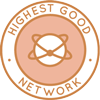 One Community is re-establishing abundant natural systems through open source Highest Good Network® software that is a web-based application for collaboration, time tracking, and objective data collection. The purpose of the Highest Good Network is to provide software for internal operations and external cooperation. It is being designed for global use in support of the different countries and communities replicating the One Community sustainable village models and related components.
One Community is re-establishing abundant natural systems through open source Highest Good Network® software that is a web-based application for collaboration, time tracking, and objective data collection. The purpose of the Highest Good Network is to provide software for internal operations and external cooperation. It is being designed for global use in support of the different countries and communities replicating the One Community sustainable village models and related components.
This week, the core team continued their work on the Highest Good Network PRs testing, confirming the fixed PRs. The resolved HGN PRs included a margin correction within report details views (PR #2493). Unresolved issues targeted task dropdowns on project reports (PR #2376) and identified UI inconsistencies on smaller screen sizes (PR #2391) and a detailed report with descriptions, images, and videos documenting five specific problems was submitted. Additional activities included setting up a test account for time tracking (PR #996) and core team functionalities (referencing PR #958), as well as further investigation into link overflow issues within team weekly summaries. See the Highest Good Society and Highest Good Network pages for more on how this relates to re-establishing abundant natural systems. The collage below shows some of their work.
ALPHA SOFTWARE DEVELOPMENT TEAM
The Alpha Team’s summary, covering their work on the Highest Good Network software was managed by Zuqi Li (Administrative Assistant and Economic Analyst) and includes Anand Seshadri (Software Engineer), Carlos Gomez (Full-stack Software Developer), and Jordy Corporan (Software Engineer). The Highest Good Network software is how we will manage and measure our processes for re-establishing abundant natural systems across our social architecture, construction, production, and maintenance processes. This week, Anand focused on adding unit tests for the BadgeManagement.jsx page, testing key areas such as rendering the component with various props and states, verifying tab switching functionality, ensuring proper interaction with the Redux store, testing the interaction with the EditableInfoModal, and confirming that the component renders when dark mode is toggled. Additionally, he performed a final review of PR 2517. Carlos addressed and resolved GitHub comments and new conflicts in FPR #2503 with the development branch. He also tested Abi’s BPR #1062, which related to queries regarding volunteer hours stats and work distribution stats. The initial review indicated that the endpoint functioned correctly, though the totalHoursWorked array was empty. A subsequent review revealed inconsistencies between the results in workDistributionStats, volunteerHoursStats, and the totalHoursWorked value. Jordy continued making progress on the unit tests for the emailController, completing the tests for the first function inside the controller. He is now focused on working through the remaining controller functions, encountering some blockers but remaining committed to finding solutions. See the Highest Good Society and Highest Good Network pages for more on how this relates to re-establishing abundant natural systems. View some of the team’s work in the collage below.
BINARY BRIGADE SOFTWARE DEVELOPMENT TEAM
The Binary Brigade Team’s summary overseeing advancements in the Highest Good Network software was managed by Min Sun (Software Engineer) and includes Aaryaneil Nimbalkar (Software Developer), Deepthi Kannan (Software Engineer), Huijie Liu (Software Engineer), Peizhou Zhang (Software Engineer), Sandhya Adavikolanu (Software Developer), Sri Sudersan Thopey Ganesh (Software Engineer), and Vijay Anand Pandian (Full Stack Software Engineer). The Highest Good Network software is how we’ll be managing and objectively measuring our process for re-establishing abundant natural systems through our social architecture, construction, production, and maintenance processes.
This week, Aaryaneil focused on creating unit tests for several components, including WeeklySummaryOptions, DeleteBadgePopup, and PeopleTasksPieChart. These tests were designed to cover various scenarios, such as rendering in different modes, handling user interactions, and verifying accessibility attributes. Aaryaneil finalized these tests and submitted the necessary pull requests to ensure the components functioned correctly across different conditions. Deepthi concentrated on PR reviews, UI updates, and documentation. She addressed styling consistency in PR2554, improved input field padding and responsive design in PR2426, and updated the user manual by incorporating new images and addressing feedback from Tatyana to keep the documentation accurate and current. Her work ensured that the UI remains consistent and user-friendly across different devices and screen sizes. Huijie resolved a bug related to user permissions that resulted from previous merge conflicts, preparing PR#1004 for merging. She also submitted PR#2584, addressing issues with the role distribution pie chart. Additionally, Huijie worked on fixing the ability to edit start and end dates in forms, resolving issues with alerts after each keyboard input and addressing limitations related to date selection, while continuing to implement form validation, contributing to re-establishing abundant natural systems.
Peizhou addressed an issue related to project category management, ensuring that the category remained specific when adding new projects and allowed changes to current project categories. He solved the issue and submitted a tested pull request, contributing to better project management functionality within the system. Sandhya made significant progress in stabilizing the HGN Software Development project by integrating the TaskCompletedBarChart component with the Redux store. She refined error handling, improved authentication flow by encapsulating token management logic, and resolved critical issues such as API errors, memory leaks, and process environment configurations. Her work enhanced the application’s stability, security, and overall performance, all while re-establishing abundant natural systems in the process. Sri worked on enhancing an existing API by adding a comparisonPeriod parameter to improve statistical analysis of volunteer activities. This enhancement required modifications to the API’s logic and data processing functions to handle the new comparison feature effectively. Sri laid the groundwork for these changes, but the task is still in progress as further adjustments are needed. Vijay worked on enhancing the user experience within the HGN Software Development project by adding a search-by-name feature to the leaderboard component and disabling the assign badge button unless a name is typed. He also did PR reviews on several issues, including enabling time entry deletion permissions, fixing email validation and success message placement, addressing dark mode label issues, and resolving a mobile view problem related to text color updates. See the Highest Good Society and Highest Good Network pages for more on how this relates to re-establishing abundant natural systems. View some of the team’s work in the collage below.
BLUE STEEL SOFTWARE DEVELOPMENT TEAM
The Blue Steel Team’s summary, presenting their work on the Highest Good Network software was managed by Jingyi Jia (Software Engineer, Team Manager), and includes Imran Issa (Software Developer), Jay Srinivasan (Software Engineer), Parth Rasu Jangid (Software Developer), Ramakrishna Aruva (Software Engineer), and Vishavdeep Kaur (Full stack Developer). The Highest Good Network software is how we’ll be managing and objectively measuring our process for re-establishing abundant natural systems through our social architecture, construction, production, and maintenance processes. This week, Jingyi completed the “time-off indicator on the leaderboard” feature, ensuring it now displays when a person has scheduled time off and grays out the names of members who are currently on time off. The feature also introduces a “+num” indicator for members with additional weeks off and displays the weeks until a member’s future scheduled time off, visible only to users with roles at or above manager level. Meanwhile, Jay focused on providing individual feedback to Team Blue Steel on their summaries and media folders, resolved pie chart color discrepancies in people reports, and completed reviews for PR 2558, PR 2508, PR 2530, and PR 2536. Ramakrishna tackled failing test cases using React Testing Library and Jest, resolving one of the issues. Parth developed test cases for the taskController, focusing on the postTasks function and reviewed four pull requests. Imran completed the automation of code assignments to teams and addressed merge conflicts in preparation for merging his PRs. Lastly, Vishavdeep verified functionalities against the HGN Bugs document across various screen sizes, reviewed and tested multiple PRs, addressing errors and providing feedback to ensure all functionalities are up to standard without further issues. See the Highest Good Society and the Highest Good Network pages to learn more on how their work contributes to re-establishing abundant natural systems. See below to view images of their work.
CODE CRAFTERS SOFTWARE DEVELOPMENT TEAM
The Code Crafters Team’s summary, covering their work on the Highest Good Network software, was managed by Summit Kaushal (Backend Software Developer) and includes Ambika Kabra (Software Engineer), Chetan Sunku (Software Engineer), Ishan Miglani (Software Engineer), Niketha Anand (Software Engineer), Pranay Netha Guda (Software Engineer), Shadhrush Swaroop (Software Engineer), Rama Srikanth Kotaru (Software Engineer), and Xiaoyu (Ivy) Chen (Software Engineer). The Highest Good Network software is how we’ll manage and objectively measure our process for re-establishing abundant natural systems through our social architecture, construction, production, and maintenance processes.
Ambika implemented six pull requests across both the backend and frontend repositories, addressing a bug related to intangible time with PR #1059 and collaborating on troubleshooting merge-related issues in the development branch. Chetan completed minor changes, uploaded the email validation bug fix, and began investigating an issue with the weekly summary tabs, specifically focusing on a redirection problem when the summary button is clicked twice. Ishan resolved a redirection bug related to the earned badges purple icon, added logic to modify timelog tabs based on the URL, and addressed a similar issue with the tasks icon, submitting PR #2578 for these fixes, while also reviewing PR #2515. Niketha focused on writing test classes, seeking guidance on editing existing test cases and working on the reload icon. Pranay concentrated on reviewing numerous pull requests, logging a bug, and identifying potential bug fixes, while also contributing to re-establishing abundant natural systems within the project’s scope.
Rama worked on new features for the Bell Icon section in the Dashboard, collaborated with Jae to detail these features, and began addressing an off-by-one start date inaccuracy, though this task remains incomplete. Shadhrush fixed a bug in the ‘Send Emails’ option by adding new permission and creating new routes under the “Announcement” section. Summit assisted a badge team member in locating the badge delete feature, detailed the Badge and Actions Components, tested total hours for each category, and reviewed and tested team members’ pull requests. Ivy focused on resolving technical issues, reintroducing the badge controller code, adjusting the toggle switch per Jae’s requirements, exploring coding problems related to timer issues, and working on the final day email and deactivation email tasks. See the Highest Good Society and Highest Good Network pages for more on how this relates to re-establishing abundant natural systems. The collage below shows some of this work.
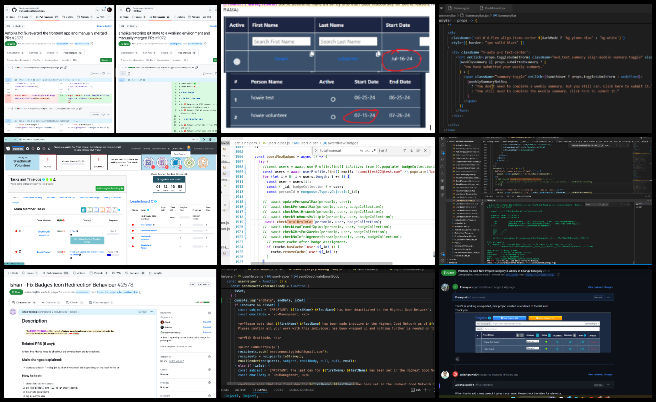
DEV DYNASTY SOFTWARE DEVELOPMENT TEAM
The Dev Dynasty Team’s summary, covering their work on the Highest Good Network software, was managed by Nahiyan Ahmed (Full Stack Software Developer) and includes Anuj Vakil (Software Engineer), Harsh Bodgal (Software Engineer), Howie Miao (Software Engineer), Jatin Agrawal (Software Engineer), Manikrishna Sanganabatla (Software Engineer), Nandini Yelmela (Software Engineer) and Sailavanya Narthu (Software Engineer). The Highest Good Network software is how we’ll manage and objectively measure our process for re-establishing abundant natural systems through our social architecture, construction, production, and maintenance processes.
Anuj made changes to the Sort Inventory button development and reviewed the BMS Dashboard codebase to identify existing components while addressing issues with the current Node.js version. Additionally, he uploaded images and videos to Dropbox. Harsh analyzed the totalorgsummary comparison functionality, discussed findings with Jae, and explained the code to a teammate to support API development. He also designed a custom Time period selection dropdown filter component. Howie focused on software development and bug fixing, including updating a previous PR #2524, documenting bugs, completing an email insert bug, and submitting a pull request for it, followed by a hotfix for a dark mode error. Jatin worked on multiple pull requests and bug fixes, completing work on various PRs, fixing merge conflicts in PR #2374, and continuing to address two bugs that are taking longer than expected. Manikrishna worked on several pull requests, fixing issues in PR #2524, reviewing multiple other PRs, providing feedback, and identifying a new bug in the HGN bug document while continuing to search for additional bugs, all with the goal of re-establishing abundant natural systems. Nahiyan worked on two pull requests, resolving issues related to the tasks and timelog component in dark mode, and fixing a numbering issue and delete icon on the projects page. Nandini addressed alignment issues in the PieChart section by improving the dark mode experience through harmonizing background and text colors, refactoring code for consistency, and testing the component’s performance before merging updates into the development branch. Sailavanya made progress on the Selecting Featured Badges task, identifying inconsistent behavior with badge displays, communicating with the team for clarification, and continuing efforts to diagnose and fix the issue to ensure a consistent user experience. See the Highest Good Society and Highest Good Network pages for more on how this relates to re-establishing abundant natural systems. The collage below shows some of this work.
EXPRESSERS SOFTWARE DEVELOPMENT TEAM
The Expressers Team’s summary, covering their work on the Highest Good Network software, was managed by Christy Guo (Software Engineer) and includes Mohammad Abbas (Software Engineer) and Reina Takahara (Software Developer). The Highest Good Network software is how we’ll manage and objectively measure our process for re-establishing abundant natural systems through our social architecture, construction, production, and maintenance processes. This week, Christy focused on enhancing the unit tests and integration tests for the teamController. She also worked on resolving errors in the test cases to ensure their accuracy and reliability. Mohammad worked on the hour delay task, spent 5 hours to refining the frontend of the progress bar and managing the state to enhance the project’s functionality. Reina focused on tracking her progress on PR#2566, addressing a request for changes after reaching out to the commenter and resolving the identified issue. In addition, she worked on updating and debugging two new pull requests, PR#722 and PR#2566, both of which required a new developer and involved updating conditional statements to allow managers and higher-level users to submit weekly summaries on behalf of others. See the Highest Good Society and Highest Good Network pages for more on how this relates to re-establishing abundant natural systems. See the collage below for the team’s work this week.
MOONFALL SOFTWARE DEVELOPMENT TEAM
The Moonfall Team’s summary, covering their work on the Highest Good Network software was managed by Lu Wang (Software Engineer) and includes Anne Zhang (Software Engineer), Gaurav Setty (Software Engineer), Shrada Chellasami (Software Engineer), Varun Kumar Reddy Guntaka (Software Engineer) and Yili Sun (Software Engineer). The Highest Good Network software is how we’ll be managing and objectively measuring our process for re-establishing abundant natural systems across our social architecture, construction, production, and maintenance processes. This week, Anne focused on resolving a bug related to badge management in the admin account system. The issue involved the deletion of badges from the admin view, which were not being correctly removed from users’ profiles. Even after badges were deleted at the admin level, they continued to appear under the “New badges earned” section on user profiles. The bug affected how badge data was filtered and displayed, requiring adjustments in the front-end logic to ensure that once a badge was deleted, it was no longer visible to users. The process involved debugging the filtering function and addressing how the badge list was rendered. Re-establishing abundant natural systems, Gaurav continued his work on PR reviews and concentrated on deepening his understanding of the codebase. He documented each PR review, captured screenshots, and uploaded them to Dropbox for easy access and future reference. By engaging with different parts of the code, he enhanced his familiarity with the project’s structure and functionality. He worked on the following PRs: #2576, #2578, #2575, #2572, #2569, #2566, #2561, #2585, #2579, #2584. Lu focused on writing and refining unit tests for the `PeopleReport/components/PeopleTasksPieChart.jsx` component. She redesigned the test cases for the selector functions to ensure accurate data filtering and processing according to the latest requirements, contributing to re-establishing abundant natural systems by improving the reliability of data-driven decisions. Lu also addressed issues related to rendering and data binding within the chart, improving performance and visual accuracy. She expanded the test cases to cover more edge cases, enhancing overall test coverage, particularly in relation to state management and asynchronous data handling errors. In addition to these technical tasks, Lu completed her team management responsibilities, including reviewing her teammates’ work. Shrada resolved a merge conflict for the task of multiple UI issues on the Projects page, focusing on screen resolutions of 375px and above, as detailed in PR2451. She addressed the problem where the loading spinner appeared alongside loaded projects and repositioned the spinner to the center. At 991px and below, she corrected the right margin, aligned the up and down arrows in the second column, and ensured the project search bar maintained consistent length with the table. She fixed the left padding issue for the two cards at 768px and below and adjusted the search bar input size at 375px. The task involved resolving a complex merge conflict with significant changes to the Projects page, which took approximately 20 hours, all while re-establishing abundant natural systems through meticulous and thoughtful design adjustments. Varun transitioned to the Development team, reviewed bugs and managerial documents, and claimed a bug related to archived projects not updating lists correctly. He made code changes to address the problem and verified the implemented changes. Yili completed 8 tasks on the User Management Page and created a PR on GitHub for these updates. These tasks included reducing the font size of the user table to minimize side scrolling, ensuring more content fits on the screen. Yili also addressed the issue with the dropdown filter next to the show button, adjusting it to display a darker background when active. In the setup invitation history modal, Yili added a bordered table and placeholders for inputs. Additionally, in the Setup New User modal, Yili resolved an issue where the full placeholder was not visible at 375px. See the Highest Good Society and Highest Good Network pages for more on how this relates to re-establishing abundant natural systems. Below is a collage for the team’s work.
REACTONAUTS SOFTWARE DEVELOPMENT TEAM
The Reactonauts Team’s summary, covering their work on the Highest Good Network software was managed by Changhao Li (Software Engineer) and includes Dhairya Mehta (Software Engineer), Diya Wadhwani (Software Developer), Hetvi Patel (Software Engineer), Jinxiong You (Software Developer), Nikhil Pittala (Software Engineer), Peterson Rodrigues dos Santos (Full-Stack MERN Stack Developer), and Vijeth Venkatesha (Full Stack Developer). The Highest Good Network software is how we’ll be managing and re-establishing abundant natural systems across social architecture, construction, production, and maintenance processes. This week, Changhao focused on unit test development for `timeentry.jsx`, managed the software development team, and addressed various development-related issues. He reviewed several previous PRs and worked on requested fixes. Changhao also hosted the weekly team meeting, created the weekly team folder for uploading photos and videos, and monitored time logs and task progress, all while re-establishing abundant natural systems through effective project management and team coordination.
Dhairya identified and resolved the root cause of a user discovery issue within the projects section by developing a sort and search function to improve user assignment processes, contributing to re-establishing abundant natural systems. Diya fixed issues related to badge export functionality, including the Reports Page Notification Checkbox Issue, and raised Pull Request #2569 with visual references. Hetvi completed database insertion, established section relations, tested search engine flow, and linked old data.
Jinxiong completed five PR reviews, specifically PR 2585, 2578, 2576, 2569, and 2558. He identified and addressed two bugs in the HGN App related to changing the system date, thus, allowing users to log time incorrectly on non-current dates. Secondly, he solved a problem on the team management page altering the team’s active status caused the page to freeze. Through his efforts, Jinxiong contributed to re-establishing abundant natural systems by ensuring the software functions smoothly and accurately, supporting the project’s broader goals.
Nikhil completed 13 pull requests, covering front-end, back-end, and unit testing tasks, enhancing his understanding of the HGN app’s codebase. Peterson enhanced the “Leaderboard” filter with a dark theme and fixed a table header issue. Vijeth researched Docker environment improvements for image deployment, addressed a timer clock issue in the HGN application, and added visual updates to the Dropbox folder. See the Highest Good Society and Highest Good Network pages for more on how this relates to re-establishing abundant natural systems. See the collage below for the team’s work this week.
SKYE SOFTWARE DEVELOPMENT TEAM
The Skye Team’s summary, covering their work on the Highest Good Network software was managed by Luis Arevalo (Software Engineer) and includes, Abi Liu (Software Developer), Angela Cheng (Full Stack Developer), Gowtham Dongari (Software Engineer), and Youyou Zhang (Full Stuck Developer). The Highest Good Network software is how we’ll be managing and re-establishing abundant natural systems on social architecture, construction, production, and maintenance processes. This week, Abi developed the volunteer reports statistics API, resolving multiple bugs in the queries and aligning his team by documenting changes and testing procedures in a pull request. He also created a hotfix to address a production issue affecting the timer and intangible hours functionality, restoring the git state for both frontend and backend applications. His efforts are integral to re-establishing abundant natural systems within our project framework and re-establishing abundant natural systems through meticulous technical solutions.
Angela completed the MailChimp replacement for the HGN Software Development project, implementing “Send Email to Specific Person” and “Broadcast Weekly Update” functionalities, and addressed image display issues in Gmail through adjustments in TinyMCE and Cheerio package versions. Gowtham refined the carry-forward logic for core team members and finalized the fix for the 5-letter-codes-dropdown, ensuring reliable functionality through extensive testing, all while re-establishing abundant natural systems as a core focus of the project.
Luis finalized his pull request, created a hotfix allowing owners to post warnings, and made the five warnings permanent. Youyou set up a local workspace on a new PC, reviewed a bug document, and collaborated with a developer to reproduce and confirm the bug locally. See the Highest Good Society and Highest Good Network pages for more on how this relates to re-establishing abundant natural systems. See the collage below for the team’s work this week.
SOFTWARE PR REVIEW TEAM A-I
The PR Review Team’s summaries for team members’ names starting with A-I and covering their work on the Highest Good Network software was managed by Vibhav Chimatapu (Data Analyst/Admin Assistant). The Highest Good Network software is a foundation of what we’ll be using to measure our results for re-establishing abundant natural systems. This week’s active members of this team were: Abdelmounaim Lallouache (Software Developer), Aditya Sure (Software Engineer), Aishwarya Ramesh (Software Engineer), Ankit Lall (Software Engineer), Arshak Badalyan (Software Engineer), Carl Bebli (Software Engineer), Yixuan(Ethan) Han (Software Developer), and Gmon Kuzhiyanikkal (Software Engineer). They reviewed all the Highest Good Network PRs (Pull Requests) shared in this week’s update. Learn more about how the Highest Good Network will measure and assist in re-establishing abundant natural systems in the Highest Good Network open source hub. The collage below shows a compilation of the work from this team.
SOFTWARE PR REVIEW TEAM J-Q
The PR Review Team’s summary for team members’ names starting with J-Q and covering their work on the Highest Good Network software was managed by Saumit Chinchkhandi (Administrative Assistant and Software Engineer). The Highest Good Network software is a foundation of what we’ll be using to measure our results of re-establishing abundant natural systems. This week’s active members of this team were: Kurtis Ivey (Software Engineer), Lin Khant Htel (Software Developer) and Nathan Hoffman (Software Engineer). They reviewed all the Highest Good Network PRs (Pull Requests) shared in this week’s update. Learn more about how the Highest Good Network will measure and assist in re-establishing abundant natural systems in the Highest Good Network open source hub. The collage below shows a compilation of the work from this team.
SOFTWARE PR REVIEW TEAM R-S
The PR Review Team’s summary for team members’ names starting with R-S and covering their work on the Highest Good Network software was managed by Olawunmi “Ola” Ijisesan (Administrative and Management Support) and Mrudula Chavali (Administrative Assistant and Data Analyst). The Highest Good Network software is a foundation of what we’ll be using to measure our results of Re-establishing Abundant Natural Systems. This week’s active members of this team were: Sai Preetham Dongari (Full Stack Developer), Shefali Mittal (Volunteer Software Engineer), Shengwei Peng (Software Engineer), Swathi Dharma Sankaran (Software Engineer), Satya Shanthi Tadiparthi (Software Engineer), Snehal Dilip Patare (PR Reviewer). She reviewed all the Highest Good Network PRs (Pull Requests) shared in this week’s update. Learn more about how the Highest Good Network will measure and assist in Re-establishing abundant natural systems in the Highest Good Network open source hub. The collage below shows a compilation of the work from this team.
SOFTWARE PR REVIEW TEAM T-Z
The PR Review Team’s summary for team members’ names starting with T-Z and covering their work on the Highest Good Network software was managed by Olawunmi “Ola” Ijisesan (Administrative and Management Support) and Samarth Urs (Administrative Assistant and Data Analyst). The Highest Good Network software is a foundation of what we’ll be using to measure our results of re-establishing abundant natural systems. This week’s active members of this team were: Xiao Wang (Software Engineer) and Yiyun Tan (Software Engineer). They reviewed all the Highest Good Network PRs (Pull Requests) shared in this week’s update. Learn more about how the Highest Good Network will measure and assist in re-establishing abundant natural systems in the Highest Good Network open source hub. The collage below shows a compilation of the work from this team.
AND WE PRODUCED THIS WEEKLY UPDATES BLOG – CLICK HERE TO SUBSCRIBE
FOLLOW ONE COMMUNITY’S PROGRESS (click icons for our pages)
INVESTOR PAGES
GET INVOLVED
DONATE | WAYS ANYONE CAN HELP | MEMBERSHIP
CLICK HERE FOR ALL PAST UPDATES
 One Community
One Community


